
8 methods and tools to analyse competitors’ Google Ads

When it comes to business it’s important to understand who your competitors are and what they’re doing. According to a study, 61% of companies have missed a strategic opportunity due to not fully understanding their market and competitors. This is a big problem, as a missed business opportunity can mean a loss in potential revenue.
- In this blog, we’ll look at
- The importance of conducting competitor research
- Ways to discover who your competitors are
- The tools you can use to analyse your competitors
- The data you should be analysing
- How to use the information you discover
At the end of the post, you should feel confident in being able to conduct your own Google Ads competitor analysis. However, if you’re still struggling our award-winning team of PPC experts can help you with an account audit. Get in touch with our team for more information. Now, with lots to look into, let’s get started. It
Why you should conduct a competitor analysis
First things first, why should you even be conducting competitor research? Well, there are several reasons and it’s much more than just copying from others. This information can give you a competitive advantage and help structure your digital marketing strategies, allocate budget and resources and learn best practices. When it comes to paid media, knowing your competitors and analysing their performance isn’t a luxury, it’s a necessity.
Our PPC expert shares his insights into the importance of a Google Ads competitor analysis:

Thomas McGuigan
PPC Account Manager
Methods to conduct a Google Ads competitor analysis
At Embryo we have an award-winning PPC team who manage Google and Microsoft ads for a range of B2B and B2C businesses. As part of our PPC process, we carry out industry research for our clients, assessing the market they operate in, understanding what competitors are doing, and setting targets that are relevant to their goals. When it comes to analysing the industry and what competitors are doing there are a range of methods, which we will look into now.
Manual analysis
If you’re unsure of who your exact competitors are, then you can use Google to search for the keywords you want to target, can be a quick and easy way to quickly understand who is showing up for the terms you want to be.
In the example below, you can see that when searching for the term ‘car finance,’ Magnitude Finance, Car Finance 247, and Zuto show up in the top three paid positions, before Car Finance 247 and Cinch in the organic results.
From doing this search and seeing the results you can see how Magnitude Finance, Car Finance 247, and Zuto have structured their headlines, and what ad copy and other information they include.
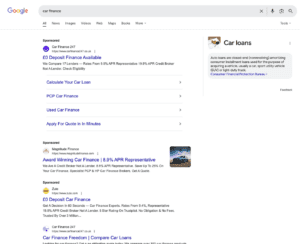
Google’s Auction Insights
Within Google Ads, you can access the Auction Insights report. This details a range of metrics such as impression share, overlap rate, position above rate and top-of-page rate.
Below is a screenshot of a business within the medical negligence industry and as you can see they own the majority share of impressions compared to other companies within the industry.
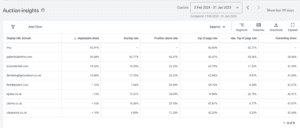
Using third-party tools
There’s a wide variety of tools available to businesses, helping them understand their competitors and measure their performance against their own by looking at various factors, such as keyword research, ad copy, landing pages and even PPC management platforms. We’re going to look into some of these tools next.
Tools to analyse your competitor’s Google Ads
So now you have some methods of analysing your market and competitors, let’s look at what tools are available to help you quickly conduct your analysis.
Google Ads Transparency Centre
Using Google’s Ads Transparency Centre, users can search by advertiser or website name to see any active ads they are running on Google. Below is a screenshot using North Property Group, and you can see all of the different ads, formats, copy and creative they are running.
This a quick and free way to analyse competitors, as long as you have their domain name.
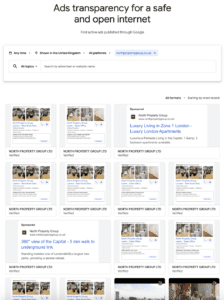
Intermingle
One of Embryo’s proprietary tools, Intermingle is a way for you to analyse the SERPs for a selection of keywords all at once. The results are then displayed as shown below so you can see who appears in the paid results and who is showing organically.
In the example below you can see keywords (‘European Single Mattress’, ‘Single Hybrid Mattress’ etc.) and then the SERP for each. You can then see who shows up in those results and in what position. For example, otty.com shows up in the top position as a paid shopping ad for the keyword ‘cheap double hybrid mattress’.
By using Intermingle you can quickly understand how competitive certain keywords are and whether a paid or organic strategy is best suited for this. If you’d like to learn more about Intermingle and receive a personalised demo, please contact our team.
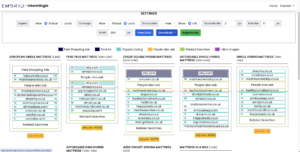
SpyFu
SpyFu is a great tool for paid and organic search, enabling users to carry out competitor analysis. For PPC, you can use the tool to see which competitors are bidding on which keywords. You can also get buy recommendations and negative match suggestions. The tool offers a free trial and then various payment plans to suit the user’s requirements.
Below is a snapshot of a report from SpyFu when analysing our domain. At a top level, from this part of the report, you can see who Embryo is competing against for organic and paid keywords.
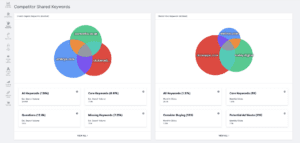
For paid keywords, you can then click more to see the search volume, the CPC, the number of ads and the number of clicks.
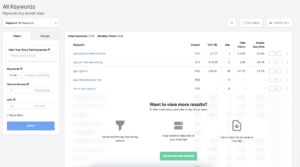
Ahrefs
Similar to SpyFu, Ahrefs is a beneficial tool for paid and organic search. By signing up for a subscription you can search any domain and access reports that look into sections such as organic search, backlink profile and paid search. Below is an example screenshot when using Jo Malone’s website. In it, you can see the keywords they are running ads for, the search volume, change in position, and even when they are updated.
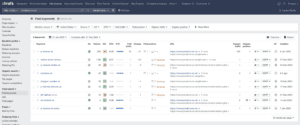
Following this you can then see the specific ads they are running, how they are performing and average traffic and keywords.
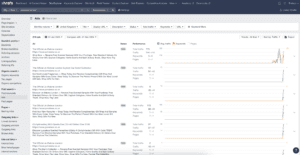
SemRush
SemRush is another paid-for tool similar to Ahrefs that allows users to analyse a domain both organically and for paid. The report can then show you your paid and organic traffic, and paid and organic keywords. You can even see the number of paid keywords for a period of time, which is great for understanding your competitor’s ad performance and behaviour.
What to look at when doing a Google Ads competitor analysis
So you have the methods and the tools, but what should you be analysing when it comes to your competitors’ Google Ads? Well, that depends on the types of ads you’re looking to run and also what you’re hoping to achieve from your PPC strategy. Below is a selection of things to assess and report on.
- Ad copy – do you need to adjust your headlines or copy to make it more engaging and to distinguish you from your competitors? Adding USPs and key information can help encourage users to engage with you over others.
- Ad creative – maybe your competitors are using more engaging creative visuals which could help inspire your own assets.
- Keywords – you could identify new keywords to target. This could be because they aren’t as competitive, or perhaps they have a higher search volume.
- Landing pages – how do your landing pages compare to your competitors? Your landing pages must be relevant to the ads they link to. Including relevant information and a CTA above the fold is also more likely to increase conversions.
- Extensions – are your competitors using extensions that you are not? This can be a great way to add more useful information to your campaigns to encourage users to take action.
By carefully assessing these aspects of your competitors’ Google ads you can use data to identify opportunities to improve your performance and achieve your goals.
Putting your findings into action
Now you know how to conduct your analysis and what you should be looking for, you then need to carry out your research and gather your information. But then what? You analyse the market, gain your information and use your learnings.
Optimise campaigns
One of the best things to do with the information you’ve learnt is to optimise your campaigns based on what you have found. For example, you might need to tweak your headlines or add more content to your ad copy.
Identify new opportunities
As well as discovering ways to optimise your campaigns, you may also find new opportunities to enhance your PPC strategy. For example, you might discover less competitive keywords to target or a better ad type to achieve your objectives.
Benchmarking for best or wrong practices
Another great outcome of competitor research is that you can identify and determine best practices for your industry, these can help make your campaigns more engaging and successful. At the same time, you can identify what you shouldn’t be doing in your campaigns, such as headlines which are too long or running adverts at times which don’t drive as much engagement.
Conclusion
To summarise, understanding your competitors’ Google Ads strategy is a necessity in ensuring PPC success. By using the methods and tools outlined in this post, you can gain valuable insights into keyword targeting, ad copy, landing page optimisation and overall campaign strategies. From manual research and leveraging Google’s Auction Insights report you can identify competitors and then leverage PPC tools to identify what your competitors are doing and what you can do to optimise your campaigns.
Remember, analysing your competitors is not so you can simply copy what they are doing, but instead identify opportunities, establish best practices and learn from their success. Armed with this information you can then make adjustments to your campaigns and budget allocation so that ultimately you increase the return on your investment in PPC.
If you still struggle with assessing your market, or perhaps you’re unhappy with your PPC performance, then contact our team of experts who have a track record for scaling hundreds of businesses.
Deeper insights
- Gain more knowledge from our PPC experts by taking a look at the following resources:
- PPC trends for 2025
- Facebook Ads vs Google Ads
- 7 stats showing the power of Demand Gen campaigns


